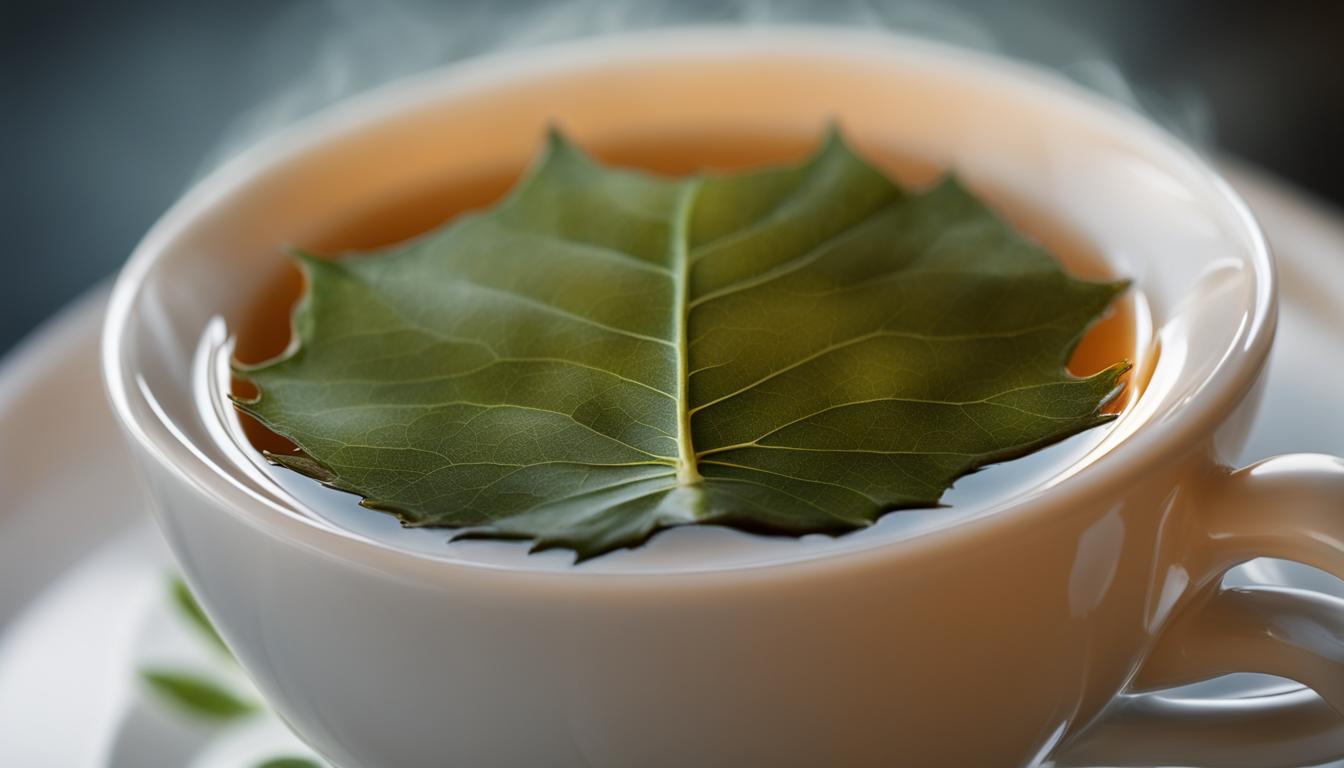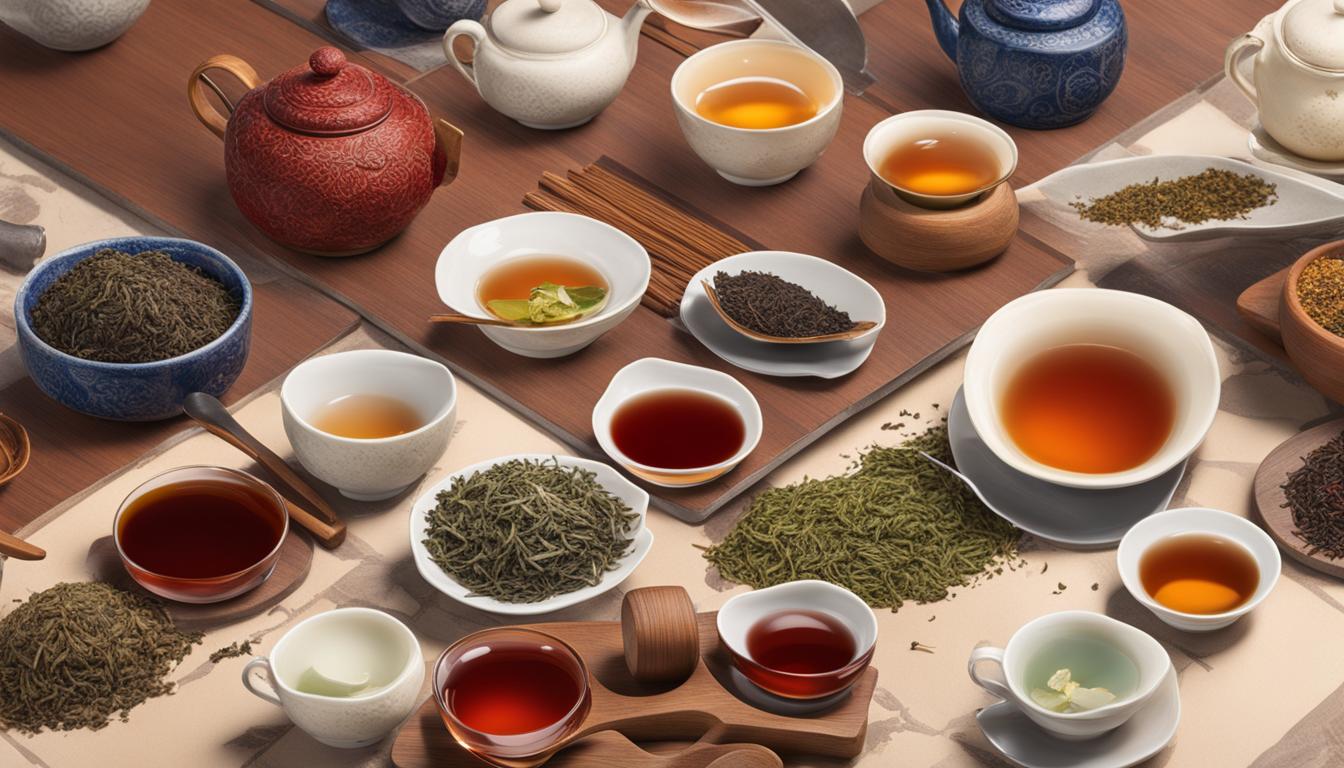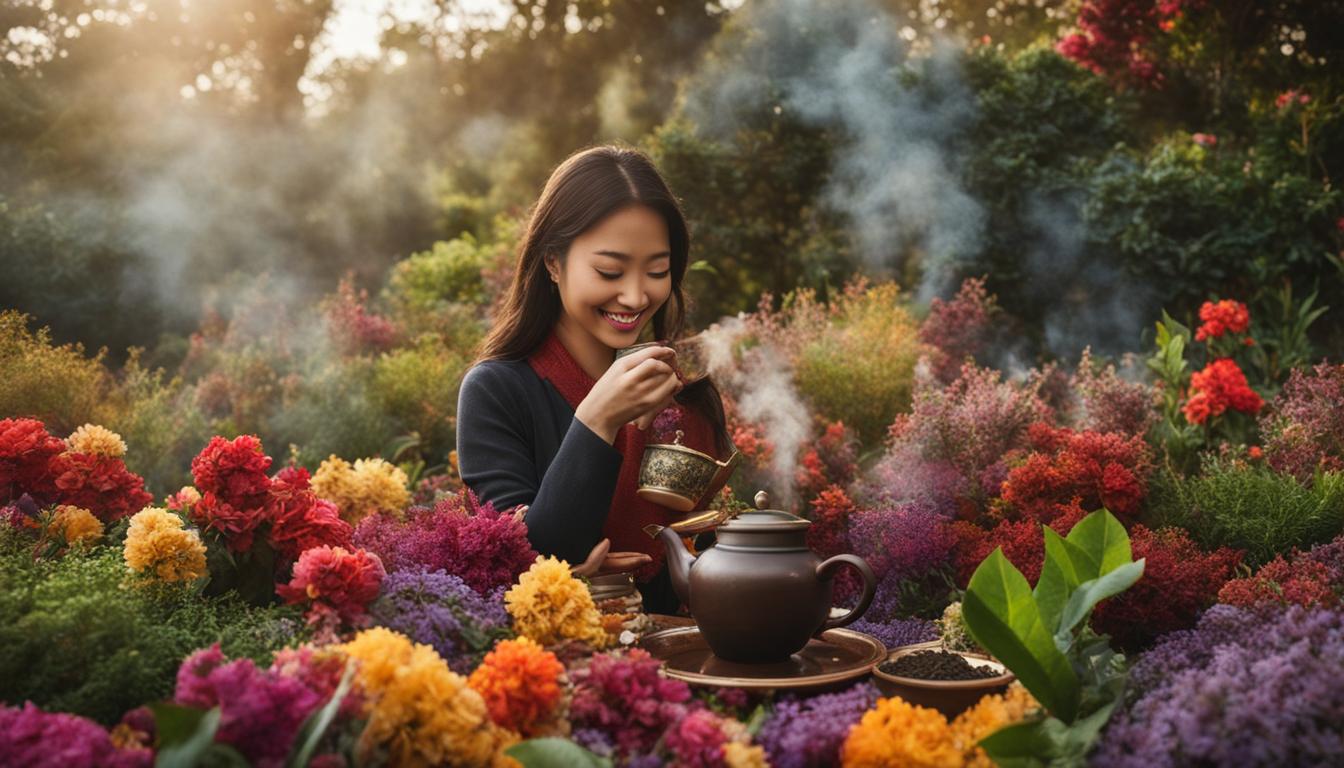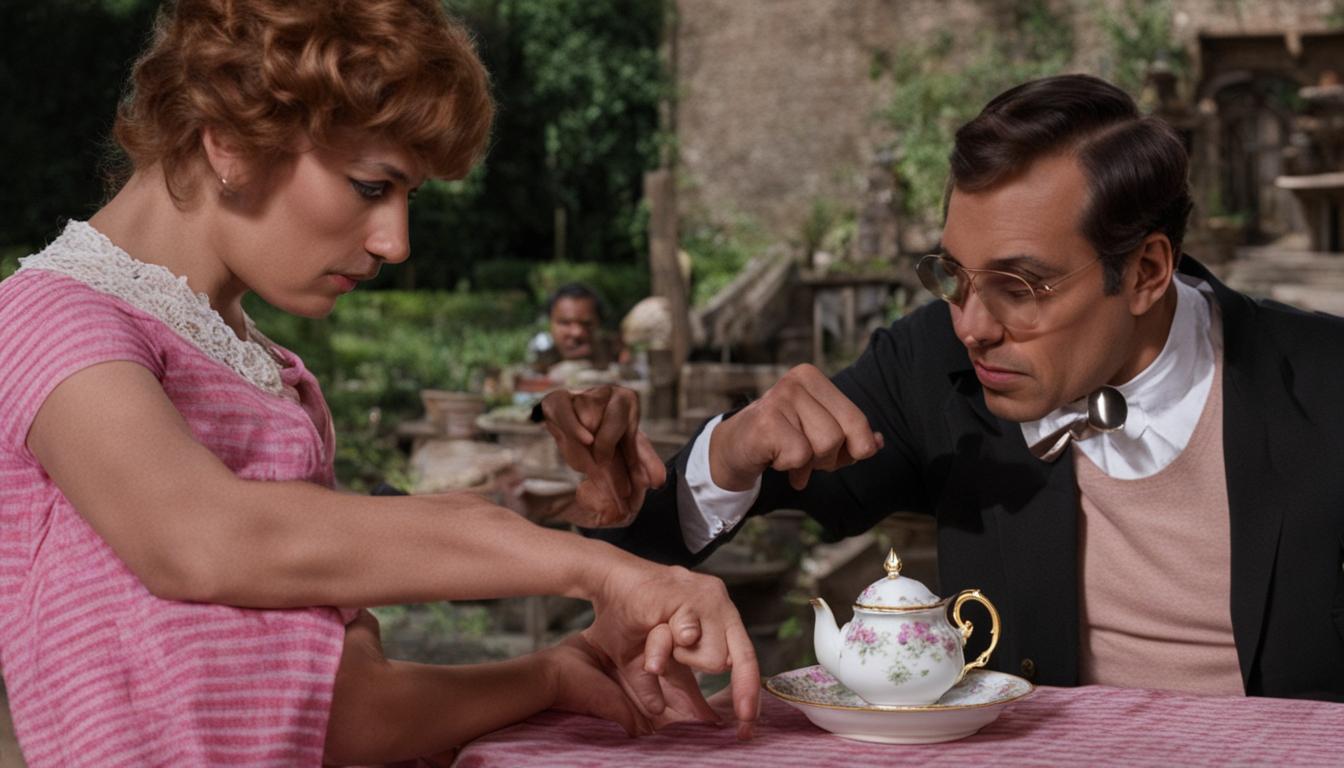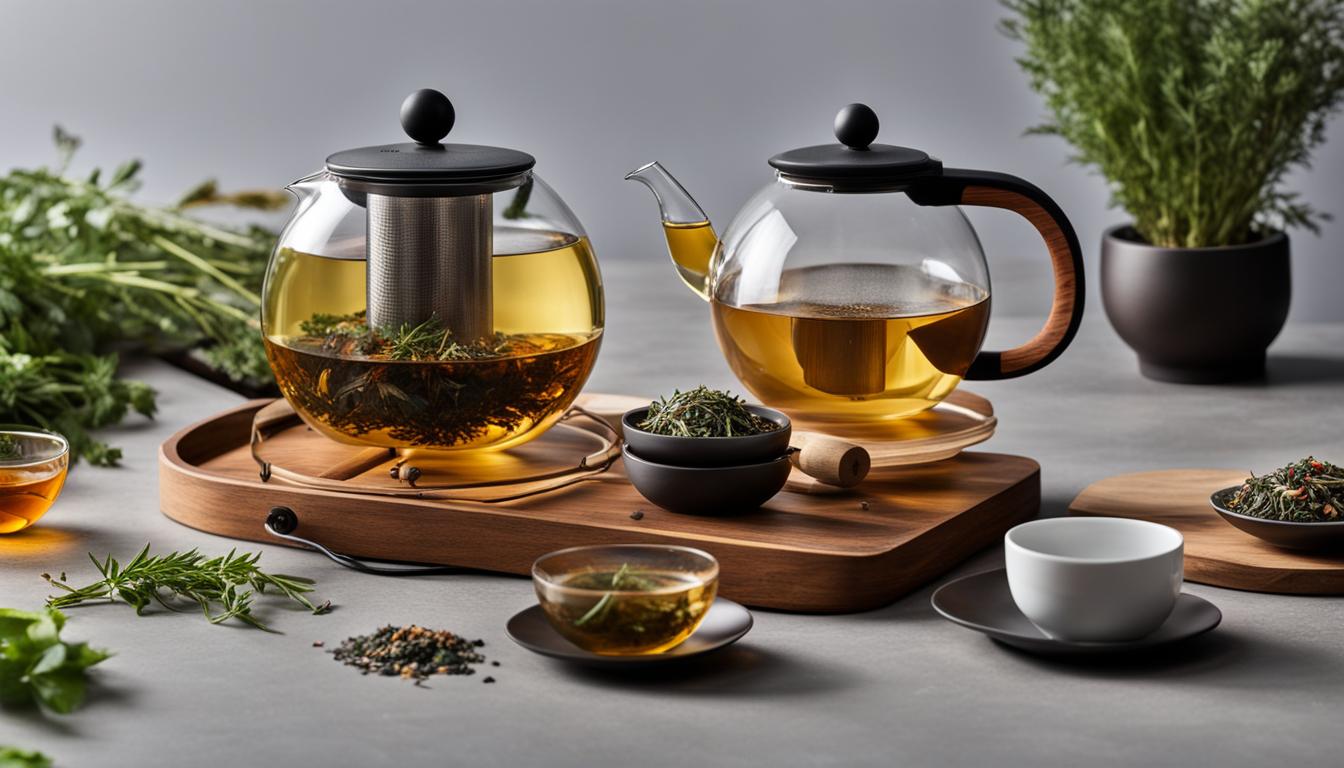Tea tasting is a fascinating journey through the senses. As we delve into the world of tea, we uncover a universe of flavors, aromas, and textures that captivate our taste buds and ignite our curiosity. In this article, we explore the intricacies of sensory analysis in tea tasting, shedding light on the techniques used to unravel the mysteries of each tea variety.
From the moment we lay our eyes on the vibrant green leaves to the lingering taste that dances on our palate, every sip of tea offers a unique sensory experience. By understanding the art of sensory analysis, we can unlock a deeper appreciation for the complexities of tea and embark on a sensory journey like no other.
Key Takeaways:
- Tea tasting involves the analysis of appearance, aroma, flavor, and texture.
- Professional tea tasters play a vital role in discerning the qualities and defects of teas.
- Tools and methods such as porcelain tasting sets and adherence to ISO standards are used in tea tasting.
- The sensory characteristics of tea encompass a wide range of flavors and aromas.
- Consumer perception of tea flavors can vary based on individual preferences and experiences.
The History of Tea Tasting
In order to understand the advanced sensory techniques used in tea tasting today, it is important to explore the rich history of this practice. Tea tasting can be traced back to China in the 8th century AD, where comparative tasting and competitions were held to evaluate different tea flavors. This tradition eventually spread to the West in the late 19th century, particularly as a response to the adulteration of tea during that time.
Professional tea tasting emerged as a way to create a universal standard of evaluation based on set parameters. These parameters included factors such as appearance, aroma, flavor, and texture. Through centuries of refinement, tea tasting has evolved into a sophisticated practice that requires highly trained senses to discern the qualities and defects of each tea sample.
Today, tea tasting continues to be a vital aspect of the tea industry, ensuring the quality and consistency of tea products. The history of tea tasting and the development of professional tea tasters have contributed to the advancement of sensory techniques and the ability to analyze tea flavors in more nuanced and detailed ways.
| Year | Significant Event |
|---|---|
| 8th century AD | Tea tasting competitions begin in China |
| Late 19th century | Professional tea tasting emerges in the West |
“Tea tasting is a fascinating blend of tradition and innovation, with its historical roots firmly planted in China. The journey of tea tasting through the centuries has led to the advanced sensory techniques we employ today. It is a testament to humanity’s timeless quest for excellence, as we continue to explore and appreciate the complex and varied flavors of tea.”
The Role of a Tea Taster
Tea tasters are the unsung heroes behind the scenes of the tea industry. With their finely tuned senses and expert knowledge, they play a pivotal role in the production and pricing of tea. Conducting sensory analysis on tea samples, tea tasters evaluate the organoleptic characteristics, such as taste and aroma, to assess the quality and consistency of the tea.
The work of a tea taster is multi-faceted and demanding. They analyze up to hundreds of samples per day, carefully assessing each one for its unique qualities and defects. By relying on their highly developed senses of taste and smell, tea tasters can identify subtle nuances and flavors that differentiate one tea from another. This expertise allows them to create unique blends by combining different types of tea to produce a desirable flavor profile.
Tea tasters are an integral part of the tea industry, ensuring that only the finest teas make it to the market. They work closely with tea producers, wholesalers, and retailers to maintain the quality and consistency of tea products. Their evaluations and recommendations influence the pricing of teas, as they can determine the value based on the sensory attributes of each sample. The role of a tea taster requires extensive knowledge of tea varieties, production methods, and sensory evaluation techniques.
Responsibilities of a Tea Taster:
- Conducting sensory analysis on tea samples
- Evaluating the taste, aroma, and appearance of teas
- Identifying qualities and defects in tea
- Creating unique blends by combining different teas
- Ensuring the quality and consistency of tea products
- Collaborating with tea producers, wholesalers, and retailers
- Influencing the pricing of teas based on sensory evaluations
Overall, tea tasters play a crucial role in the tea industry, using their trained senses and expertise to ensure the highest quality and taste experience for consumers. Their work is an essential component of the tea production process, bridging the gap between tea producers and tea enthusiasts. So, the next time you savor a cup of tea, remember to appreciate the skill and dedication of the tea tasters who have made it possible.
Tools and Methods for Tea Tasting
When it comes to tea tasting, professionals rely on a range of tools and methods to ensure a thorough sensory analysis. These techniques not only enhance the tasting experience but also allow for a standardized evaluation of different tea varieties.
Porcelain Tasting Set
One of the most essential tools in tea tasting is the white porcelain tasting set. This set typically consists of a bowl-shaped cup, a notched cup with a handle, and a lid. The porcelain material is preferred due to its neutrality, as it does not interfere with the flavors and aromas of the tea. The cups and lid are designed to maintain the optimal temperature of the tea and ensure a consistent leaf-to-water ratio. The size, shape, and other parameters of the tasting cups are guided by ISO standards, enabling a uniform approach to tea tasting.
Tasting Process
The process of tea tasting involves comparing different batches of the same tea from various plantations. This allows for a comprehensive evaluation of the qualities and defects of each sample. Tea tasters carefully observe the appearance, aroma, flavor, and texture of the brewed tea, using their senses to discern the nuances and characteristics of each cup. They pay attention to factors such as color, clarity, fragrance, taste profile, and mouthfeel. By comparing multiple samples, tea tasters can identify specific variations and make informed decisions about blending and quality.
Sensory Analysis Techniques
In addition to the porcelain tasting set, tea tasters may utilize other sensory analysis techniques to enhance their evaluation. These techniques can include aroma cups, which allow for a more concentrated assessment of the tea’s fragrance, and tasting notes, where tasters record their observations and impressions. Some professionals also incorporate ranking systems or scoring sheets to quantify the sensory attributes. The goal is to create a systematic approach that captures the complexity of the tea and provides valuable insights for producers and consumers.
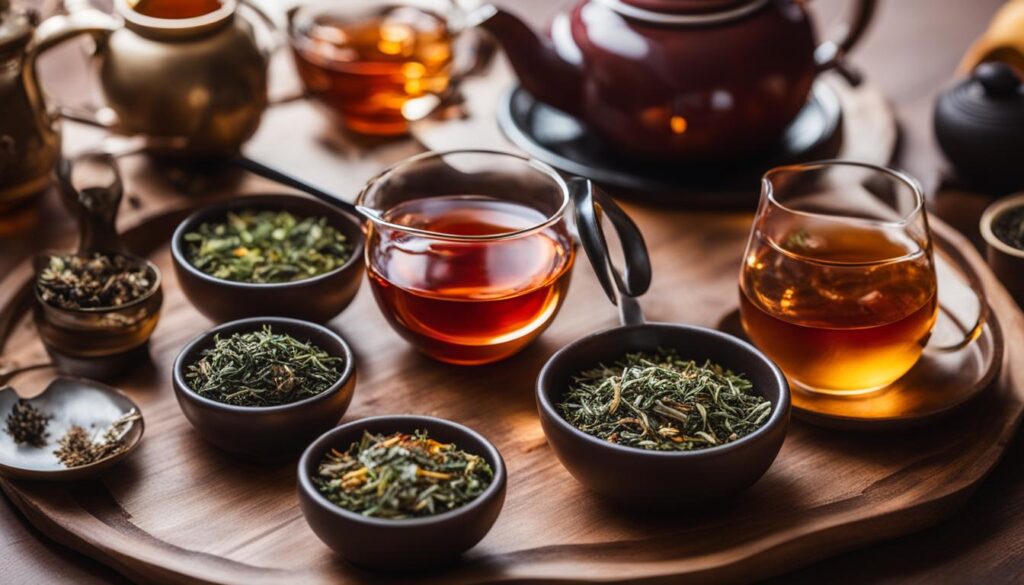
| Tool/Method | Description |
|---|---|
| Porcelain Tasting Set | A set of cups and a lid made from white porcelain, designed to maintain the optimal temperature and consistency of the tea during tasting. |
| Aroma Cups | Specialized cups that concentrate the aroma of the tea, allowing for a more focused assessment of its fragrance. |
| Tasting Notes | Recorded observations and impressions of the tea’s appearance, aroma, flavor, and texture, providing a comprehensive overview for future reference. |
| Ranking Systems | A system that assigns a numerical rank or score to the sensory attributes of the tea, enabling a more quantitative evaluation. |
The Steps of Tea Tasting
Tea tasting is a sensory experience that involves analyzing the flavors and aromas of different tea varieties. By following a systematic approach, we can fully appreciate the nuances and characteristics of each cup of tea. The process of tea tasting typically involves three main steps: analyzing the dry tea leaves, evaluating the brewed tea (liquor), and examining the wet tea leaves.
Analyzing the Dry Tea Leaves
The first step in tea tasting is to carefully examine the dry tea leaves. This involves observing their shape, color, brightness, uniformity, and integrity. The appearance of the dry leaves can provide valuable insights into the quality and processing of the tea. For example, tightly rolled leaves may indicate a higher-quality tea that has been carefully handcrafted, while broken leaves may suggest a more mass-produced tea.
Evaluating the Brewed Tea
After analyzing the dry leaves, we move on to evaluating the brewed tea, also known as the liquor. This step involves assessing the appearance, aroma, flavor, texture, and aftertaste of the tea. The appearance of the brewed tea can vary depending on factors such as the tea type, brewing method, and steeping time. Aroma plays a crucial role in tea tasting, as it contributes to the overall sensory experience. The flavor of the tea can range from delicate and nuanced to bold and robust, and the texture can vary from smooth and velvety to astringent and drying. The aftertaste, or the lingering flavors that remain in the mouth after swallowing, is also an important aspect of tea tasting.
Examining the Wet Tea Leaves
The final step in tea tasting is to examine the wet tea leaves. This involves carefully observing their appearance and aroma after the brewing process. The wet leaves can provide valuable information about the quality and processing of the tea. For example, the aroma of the wet leaves can reveal additional layers of complexity and fragrance that may not be immediately apparent in the brewed tea. Examining the wet leaves can provide valuable insights into the origin, production, and handling of the tea.
| Step | Description |
|---|---|
| Analyzing the Dry Tea Leaves | Observing the shape, color, brightness, uniformity, and integrity of the dry tea leaves. |
| Evaluating the Brewed Tea | Assessing the appearance, aroma, flavor, texture, and aftertaste of the brewed tea. |
| Examining the Wet Tea Leaves | Observing the appearance and aroma of the wet tea leaves after the brewing process. |
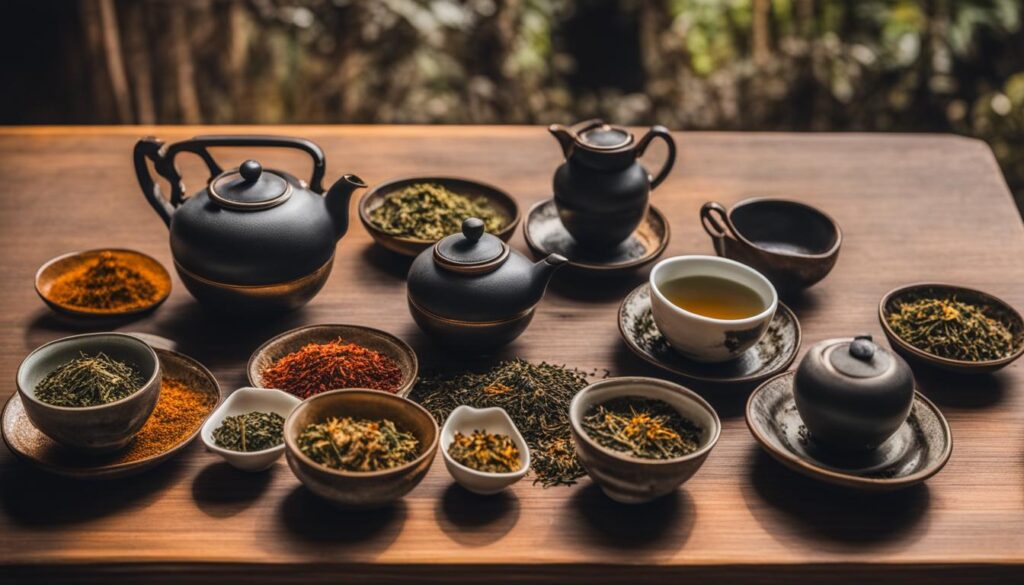
By following these steps of tea tasting, we can develop a deeper understanding of the sensory characteristics of tea and enhance our overall tea appreciation journey. Each cup of tea offers a unique sensory experience, and by sharpening our senses and paying attention to the finer details, we can unlock a world of flavors and aromas.
The Sensory Characteristics of Tea
When it comes to tea, it’s not just about the taste. The sensory experience of tea goes beyond flavor alone, encompassing a wide range of characteristics that can be appreciated by the discerning palate. From the moment you open the package and catch a whiff of its aroma to the first sip that tantalizes your taste buds, tea offers a multi-dimensional sensory journey. Let’s explore the fascinating world of tea’s sensory attributes and how they contribute to the overall tea-tasting experience.
One of the key aspects of tea’s sensory profile is its flavor. Tea can exhibit a diverse range of flavors, each with its own unique characteristics. These flavors can be classified into different families, including vegetal, fruity, floral, briny, woody, confectionery, balsamic, spiced, toasty, and even animal. The flavor profile of tea can also include qualities such as sweetness, bitterness, sourness, saltiness, and umami. These complex flavor profiles are a result of various factors, including the tea plant cultivar, growing conditions, oxidation level, and processing techniques.
In addition to flavor, the aroma of tea is another crucial sensory component. The aroma of tea can vary in intensity, persistence, and the specific notes it carries. Each tea variety has its own characteristic aroma that can range from delicate and floral to robust and earthy. The aroma adds depth and complexity to the overall tea-tasting experience and can evoke memories, emotions, and a sense of comfort.
To fully appreciate the sensory characteristics of tea, it’s important to engage all of our senses. The appearance, color, and texture of the tea leaves are visual cues that provide insights into the quality and processing of the tea. The way the tea liquor looks in the cup, ranging from a pale golden hue to a rich amber color, can also indicate the flavor profile and intensity of the tea. The mouthfeel and aftertaste further contribute to the sensory experience, with some teas leaving a lingering sweetness or a refreshing astringency.
Image:
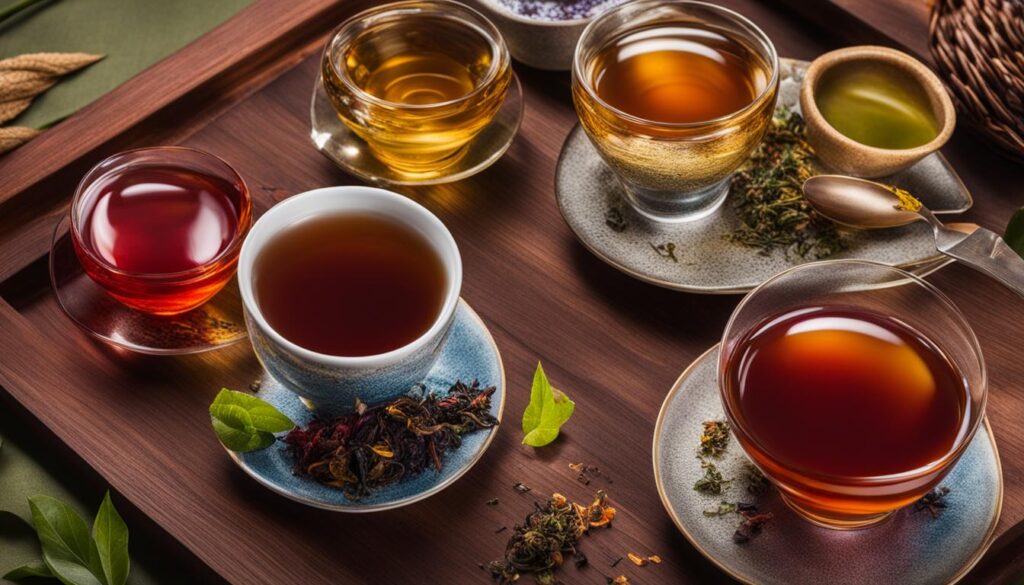
Consumer Perception of Tea Flavors
When it comes to tea, taste is highly subjective and can vary from person to person. Each individual has their own unique preferences and experiences that influence how they perceive and appreciate the flavors of tea. However, there are certain attributes that are generally preferred by consumers, while others may be considered less desirable.
According to our tea flavor sensory study, consumers tend to favor teas that have a mild and balanced flavor profile. They appreciate teas that are not overly bitter or astringent, but rather have a pleasant and smooth taste. Sweetness is often a desirable quality in tea, as it adds a touch of enjoyment to the overall experience. Consumers also tend to gravitate towards teas that have a refreshing and calming effect, making them ideal for relaxation and self-care moments.
On the other hand, strong or fermented flavors, bitterness, pungency, and excessive astringency are often perceived as less desirable by consumers. These characteristics can sometimes overpower the palate and detract from the overall enjoyment of the tea. It’s important for tea producers to understand these consumer preferences and create blends that cater to different tastes, ensuring a wide range of options that can maximize consumer satisfaction.
Key Points:
- Consumer perception of tea flavors is subjective and varies based on individual preferences and experiences.
- Consumers generally prefer teas that have a mild, balanced flavor profile.
- Sweetness and mildness are often preferred attributes, while bitterness and strong flavors are considered less desirable.
- Understanding consumer preferences is crucial for developing tea blends that cater to different tastes and ensure maximum consumer satisfaction.
| Preferred Tea Attributes | Less Desirable Tea Attributes |
|---|---|
| Mild and balanced flavor | Bitterness |
| Sweetness | Strong or fermented flavors |
| Smooth and pleasant taste | Pungency |
| Refreshing and calming effect | Excessive astringency |
By aligning with consumer preferences and creating teas that offer a delightful and satisfying taste experience, tea producers can ensure their products are well-received in the market. The sensory exploration of tea flavors allows us to uncover the nuances and subtleties that make each tea unique, guiding us in crafting blends that cater to diverse palates and enhance the overall tea-drinking experience.
Conclusion
In conclusion, the practice of tea tasting is a fascinating and intricate process that allows us to delve into the sensory world of tea. Through detailed analysis and evaluation, tea tasters provide us with a deeper understanding of the qualities and characteristics of different tea varieties. By utilizing their expert senses, they ensure that each cup of tea is of the highest quality and consistency.
The sensory evaluation of tea involves a combination of techniques and tools, such as porcelain tasting sets and adherence to ISO standards. These methods allow for a standardized and comprehensive analysis of the appearance, aroma, flavor, and texture of tea. By following these steps, we are able to appreciate the nuanced flavors and aromas that each tea variety has to offer.
By understanding the history and development of tea tasting, as well as the role of professional tea tasters, we gain a greater appreciation for the art and science behind this age-old practice. As tea enthusiasts, we can explore the world of tea with a fresh perspective, knowing that each cup has been carefully evaluated and crafted for our enjoyment. So, let’s raise our teacups and savor the detailed tasting analysis that enhances our tea-drinking experience!
FAQ
What is tea tasting?
Tea tasting is the process of analyzing and evaluating the appearance, aroma, flavor, and texture of different teas to determine their quality and characteristics.
How long has tea tasting been practiced?
Tea tasting has been practiced for centuries, with its origins dating back to China in the 8th century AD.
What is the role of a tea taster?
A tea taster is a highly skilled professional who evaluates the organoleptic characteristics of tea, analyzing up to hundreds of samples per day to ensure the quality and consistency of tea products.
What tools and methods are used in tea tasting?
Tea tasting involves the use of specialized tools such as porcelain tasting sets and adherence to ISO standards for cup size, shape, and other parameters.
What are the steps of tea tasting?
Tea tasting typically involves three steps: analyzing the dry tea leaves, evaluating the brewed tea (liquor), and examining the wet tea leaves.
What are the sensory characteristics of tea?
Tea possesses a wide range of sensory characteristics, including flavors and aromas that can be categorized into different families such as vegetal, fruity, floral, and more.
How does consumer perception affect tea flavors?
Consumer perception of tea flavors is subjective and can vary, but certain attributes like sweetness and mildness are generally preferred over bitterness or strong flavors.
What is the purpose of sensory analysis in tea tasting?
Sensory analysis allows for a comprehensive evaluation of the sensory characteristics of tea, helping to ensure its quality and consistency.

